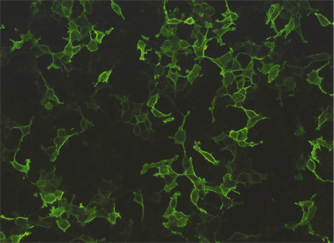Clinical information
Membranous nephropathy is a chronic inflammatory disease of the glomeruli that is accompanied by progressive impairment of the kidney function. It is the most frequent cause of nephrotic syndrome in adults.
A distinction is made between the primary form (pMN), which has an autoimmune origin and accounts for about 70% to 80% of cases, and the secondary form (sMN), which develops from an underlying disease such as an infection, from the use of medication, drugs or toxins or from another autoimmune disease or cancer. The onset of pMN is gradual and varies from patient to patient. About one-third of patients experience spontaneous remission, one-third continue to suffer from proteinuria with stable renal function, and another third progress to end-stage renal disease (ESRD).
Diagnostics

Autoantibodies against phospholipase A2 receptor (PLA2R) and thrombospondin type 1 domain-containing protein 7A (THSD7A) are characteristic of pMN. Anti-PLA2R antibodies occur in pMN with a prevalence of 70% to 80%, while anti-THSD7A antibodies can be found in 3% to 5% of patients. Anti-THSD7A antibodies are predominantly detected in anti-PLA2R-negative patients and therefore play a complementary role in serodiagnosis. The specificity of both antibodies for pMN is very high. For a long time, kidney biopsy was considered the gold standard for diagnosing pMN. However, according to the current KDIGO guideline, pMN can be diagnosed in nephrotic patients with positive anti-PLA2R antibody results without performing an additional biopsy. Only in the case of anti-PLA2R-negative results or in patients with impaired renal function who are receiving immunosuppressive therapy should a biopsy still be considered, as the antibody titer may be reduced by the treatment. Anti-PLA2R antibodies also correlate with the clinical activity of the disease. With successful immunosuppressive therapy, the titer drops within a short time. The determination of the antibody titer is therefore a suitable tool for monitoring the disease status and the patient’s response to therapy.
pMN-associated autoantibodies can be determined with test systems exclusively available from EUROIMMUN. The indirect immunofluorescence test (IIFT) enables the qualitative and semi-quantitative detection of anti-PLA2R and anti-THSD7A antibodies, respectively, using transfected cells that express the corresponding antigen on their surface. However, anti-PLA2R antibodies can also be measured quantitatively by ELISA or chemiluminescence immunoassay (ChLIA). In ELISA, the recombinant PLA2R antigen is applied to the wells of a microplate, while ChLIA uses magnetic particles coated with the antigen. Quantitative antibody measurement is ideal for disease and therapy monitoring and can be performed efficiently and with high throughput thanks to state-of-the-art automation solutions.


















